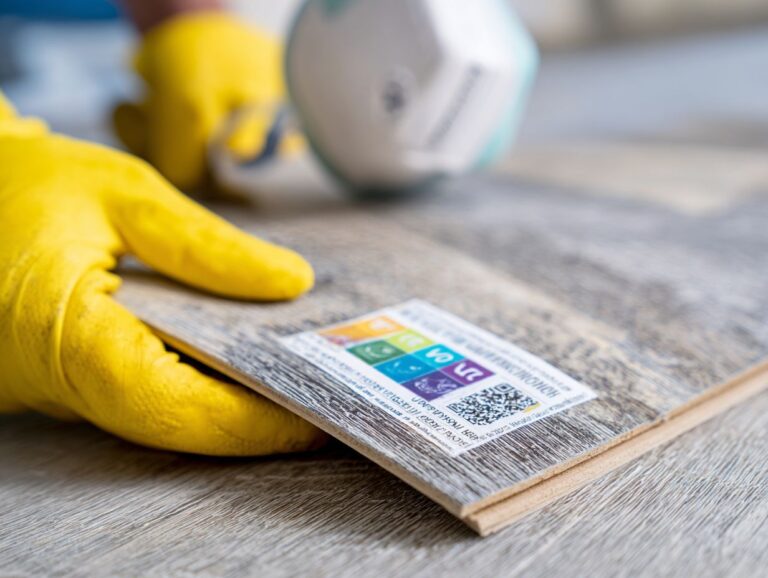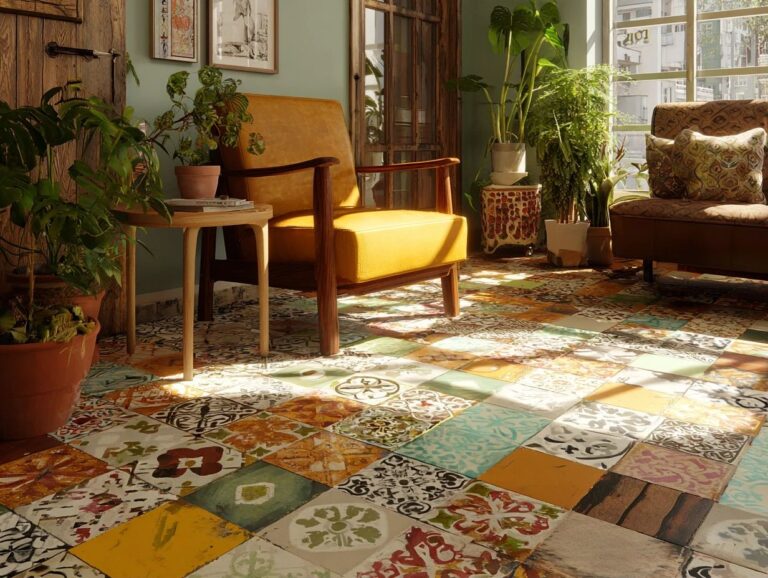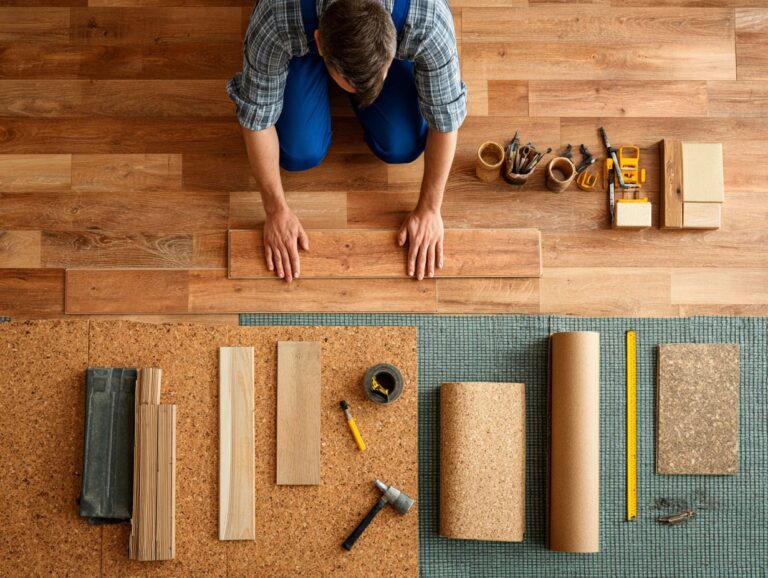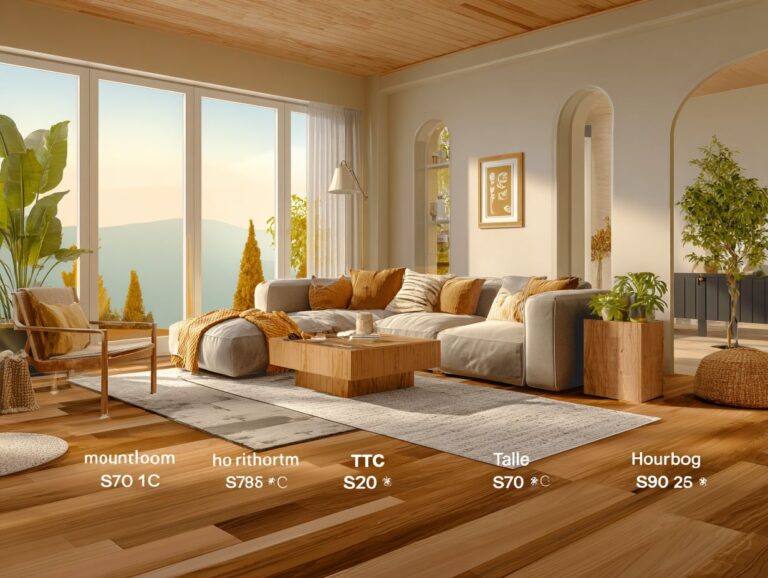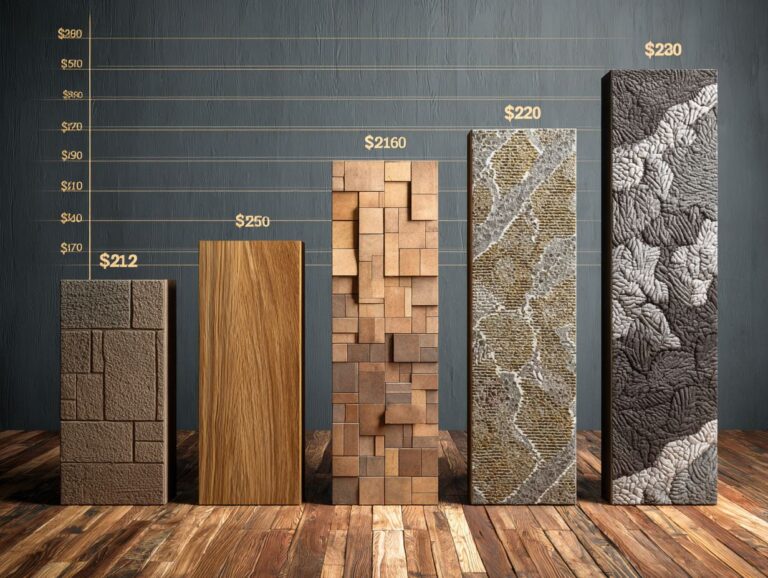When to Refinish vs Replace Flooring – Decision Guide
Contents
- Introduction
- Flooring Refinishing vs. Replacement: Environmental and Cost Implications
- Understanding Flooring Types
- Signs Your Flooring Needs Attention
- Refinishing Flooring
- Replacing Flooring
- Cost Analysis
- Frequently Asked Questions
- When should I consider refinishing my flooring instead of replacing it?
- What are some signs that it’s time to replace my flooring?
- How do I determine if my flooring is in good enough condition to be refinished?
- Is refinishing or replacing flooring more cost-effective?
- Can I refinish my flooring myself or should I hire a professional?
- Will refinishing my flooring change its color or appearance?
Introduction
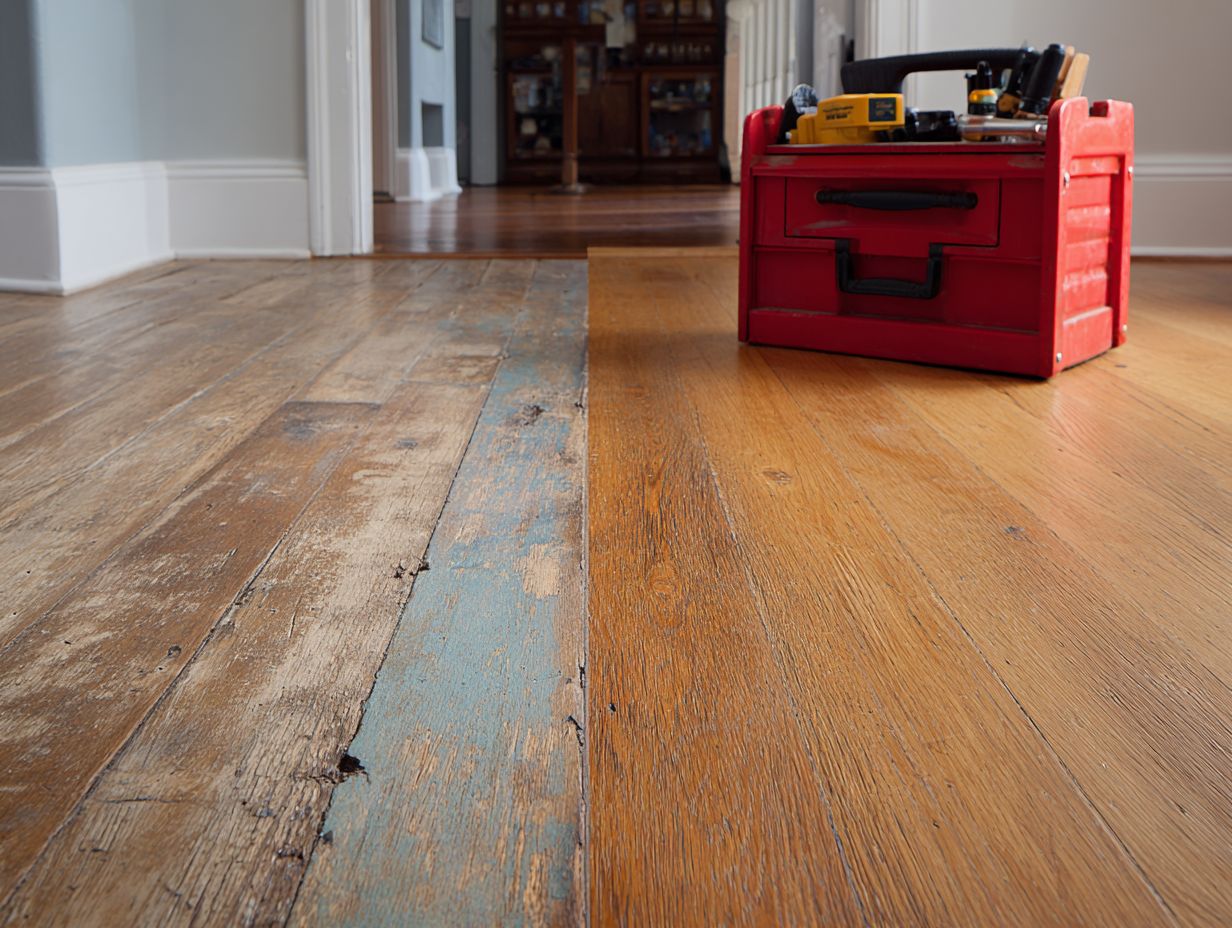
Key Takeaways:
Importance of Flooring Decisions
Picking the right flooring is important for homeowners because it impacts how the home looks and how easy it is to care for.
For example, hardwood floors add a cozy and stylish touch, giving rooms a bigger and more welcoming appearance. They need regular cleaning and maintenance to avoid getting scratched. This seasonal flooring maintenance checklist can help ensure your hardwood stays in perfect condition year-round.
In contrast, luxury vinyl plank offers a budget-friendly, water-resistant alternative with a wide variety of designs that mimic wood or stone, ideal for high-traffic areas.
Ceramic tiles are durable and simple to clean, making them a great option for upgrading the appearance of bathrooms and kitchens.
In the end, the best option should fit your way of living, budget, and the design plan for your home.
Overview of Refinishing vs Replacing
Knowing the difference between fixing up and completely changing flooring is important for homeowners who want to take care of their property wisely.
Refinishing is generally a cost-effective way to restore the beauty of hardwood floors, costing between $3 to $5 per square foot. This process involves sanding down the surface and applying a new finish, effectively removing scratches and color fading.
In contrast, replacing flooring can range from $8 to $14 per square foot, depending on the material. If the current floors are very damaged or old, putting in new ones might be the best choice. See also: our guide on Engineered vs Solid Hardwood – Pros, Cons & Cost Differences to understand material choices better.
Always consider the long-term value of your investment when deciding between these two approaches.
Flooring Refinishing vs. Replacement: Environmental and Cost Implications
Flooring Refinishing vs. Replacement: Environmental and Cost Implications
Environmental Impact: Carbon Footprint Reduction
Cost and Time Comparison: Cost of Flooring Options
Cost and Time Comparison: Downtime
The comparative analysis of Flooring Refinishing vs. Replacement emphasizes the environmental and cost benefits associated with refinishing, as opposed to complete floor replacement. This data offers important information for homeowners and businesses wanting to choose sustainable and cost-effective flooring.
Environmental Impact data shows substantial carbon footprint reductions when opting for floor refinishing. There is a 78% reduction in carbon emissions when choosing general refinishing over replacement. The benefits are even more pronounced with resilient floors, where refinishing yields a 92% reduction in carbon emissions. These statistics highlight refinishing as an environmentally preferable choice, significantly lowering the carbon impact associated with flooring projects by extending the lifecycle of existing materials and reducing waste.
- Cost and Time Comparison: The financial effects are just as important. The cost of refinishing is markedly lower at $2,000, compared to a hefty $8,000 for a total replacement. This large cost difference shows that refinishing is an affordable option, offering similar visual improvements at a much lower cost.
- Moreover, refinishing requires only one week of disturbance, while changing floors requires four weeks. The shorter time required decreases hassle for residents and reduces interruptions to businesses, enabling them to resume normal activities faster.
In summary, opting for floor refinishing over replacement significantly benefits both the environment and finances. The significant drop in carbon emissions, along with cost savings and less downtime, make refinishing a great choice for those focused on being environmentally friendly and saving money. This information indicates that refinishing is a practical and clever choice for taking care of floors.
Understanding Flooring Types
Homeowners need to know that each type of flooring has specific features, care requirements, and visual styles. For an extensive analysis of preventative measures and repair techniques, our comprehensive guide on pet damage to flooring offers valuable insights.
Hardwood Flooring

Hardwood flooring is well-known for being strong and attractive, which makes it a common option for homeowners who want a floor that looks good and lasts a long time.
One of the standout benefits of hardwood flooring is its ability to be refinished. This process can revive worn or scratched floors, potentially doubling their lifespan of 25-30 years.
Refinishing typically costs between $1.50 and $4.00 per square foot, depending on the wood type and finish used. Regular care, like sweeping and using a wood cleaner, extends the life of the wood.
For those considering an upgrade, the initial investment often ranges from $8 to $15 per square foot, reflecting hardwood’s premium quality and timeless appeal.
Laminate Flooring
Laminate flooring provides an affordable alternative to hardwood, offering a similar look without the high price tag.
Typically priced between $1 and $5 per square foot, laminate is a budget-friendly flooring option that mimics the appearance of wood or stone. Installation is user-friendly, often requiring just interlocking pieces that don’t necessitate glue or nails.
Laminate is better at resisting scratches and stains than hardwood, which makes it great for areas where people walk frequently. It does have less durability over time compared to vinyl, which is waterproof and more resilient.
In the end, your decision should be based on the room’s conditions and how much you can spend.
Vinyl Flooring
Vinyl flooring is notable for being waterproof and easy to clean, which makes it perfect for busy areas and places with a lot of moisture.
There are three primary types of vinyl flooring:
- Sheet vinyl, typically costing $1.50 to $5.00 per square foot, is excellent for large areas without seams, enhancing water resistance.
- Vinyl tiles range from $1 to $5 per square foot, allowing for unique design patterns and easy replacement of individual tiles.
- Luxury vinyl planks (LVP), priced between $2 and $7 per square foot, offer a more authentic wood look and feel.
To maintain these floors, regular sweeping and damp mopping are sufficient, ensuring their longevity and appearance.
Tile Flooring
Tile flooring works well in places where you need water resistance and various design choices.
Ceramic tiles are popular for kitchens due to their durability and ease of cleaning, typically costing between $1 to $5 per square foot.
Porcelain tiles, denser and less porous, work well in bathrooms where water exposure is high, usually priced from $3 to $10 per square foot.
Natural stone tiles like slate or marble offer unique aesthetics for living areas but require more maintenance and can range from $5 to $15 per square foot.
Consider your space’s specific needs and your maintenance preferences when choosing the appropriate tile material.
Signs Your Flooring Needs Attention
Knowing when your flooring needs care can help homeowners avoid more damage and expensive fixes.
Visible Damage and Wear
Visible damage like deep scratches and dents can make your flooring look worse, which may lead to refinishing or replacement.
Begin by assessing the extent of the damage. Look for specific signs like loose boards, gaps between planks, and water stains.
For minor scratches, buffing with a fine-grit sandpaper can restore the finish. If the damage is worse, think about using a wood filler to fix dents before sanding and refinishing the spot.
For extensive wear, blending in a new stain may be necessary. Tools like a floor sander or a paintbrush for small fixes can be very helpful in this process. Always keep your workspace clean to prevent extra scratches.
Water Damage Indicators
Water damage manifests as discoloration, warping, or mold growth, indicating serious issues that may require immediate attention.
To assess water damage in flooring, start by examining the type of material. For hardwood, look for buckling or gaps between boards; in laminate, check for swelling or uneven surfaces. Carpeting often reveals stains or dampness.
Use a moisture meter to measure levels-anything above 16% generally indicates a problem.
For remediation, consider hiring professionals for extensive damage, but minor issues can often be addressed using a dehumidifier, fans, and specialized cleaning solutions.
Always provide good airflow to prevent mold from forming while things dry.
Noise and Movement Issues
Strange sounds and movement from the floor can indicate hidden issues that might get worse if not fixed quickly.
Start by identifying the type of sound; creaking often suggests the boards are not tightly secured, while popping might indicate air is stuck.
For minor creaks, applying talcum powder in the gaps can reduce friction.
Check floor joists for stability; if they’re sagging, consider reinforcing them.
If noises persist or structural shifts are evident, it might be time to hire a professional inspector. They can examine the base and offer specific solutions, keeping your flooring safe and steady.
Refinishing Flooring
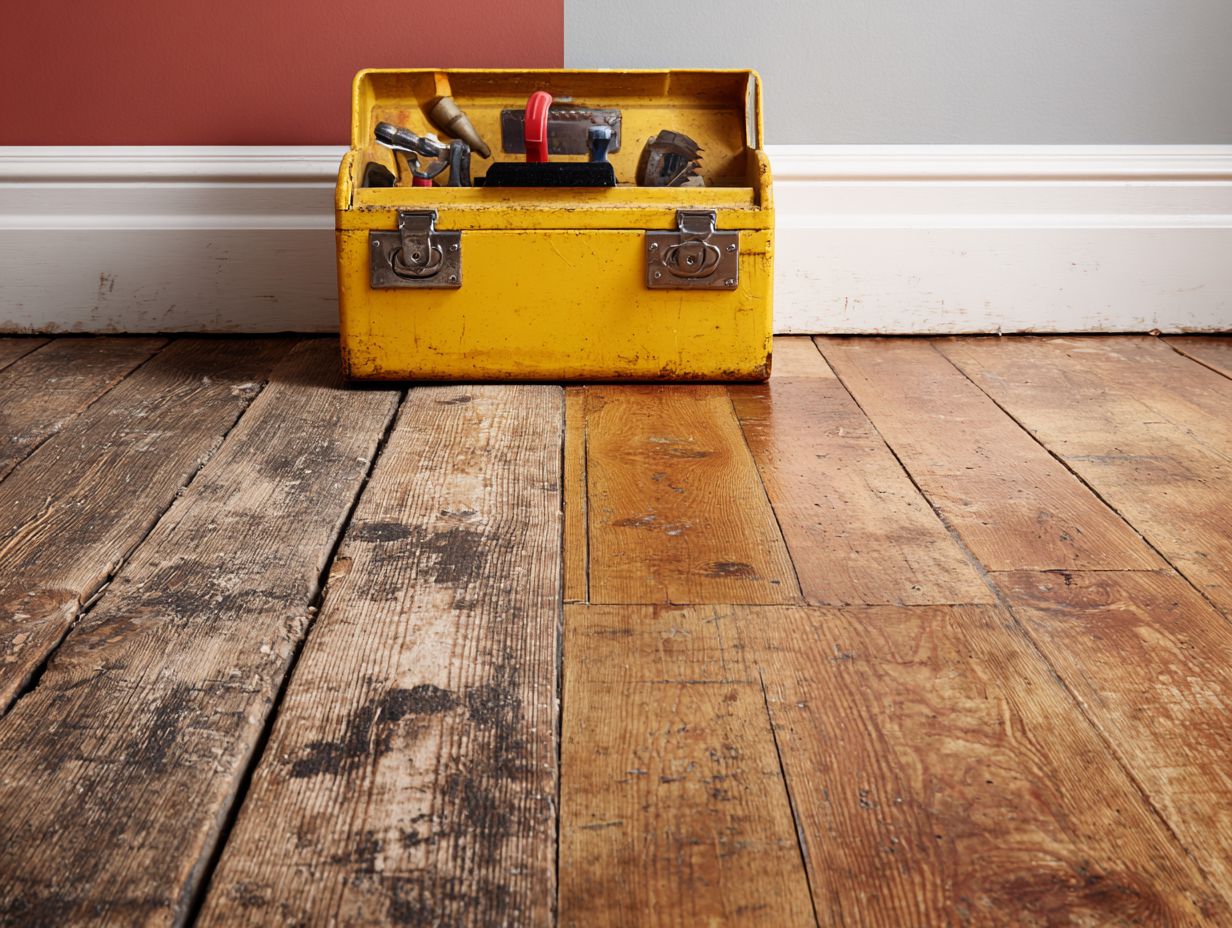
Refinishing hardwood floors brings back their appearance and is usually the most affordable way to keep them in good shape.
Benefits of Refinishing
Refinishing can increase a home’s value by up to 30% while drastically improving the aesthetic appeal of hardwood floors.
To achieve these benefits, homeowners can follow a few specific steps.
- Start by assessing the floor’s condition-look for scratches, dents, or discoloration.
- Next, select a reliable refinishing contractor or consider DIY if you have the experience. For those interested in understanding different types of hardwood floors, there is a complete guide to hardwood flooring types and species available.
- Popular tools for DIY refinishing include a drum sander (around $40/day rental) and a buffer ($20/day rental).
- Once your floors are sanded down to bare wood, apply a finish like polyurethane for durability.
This whole process typically costs between $1.50 to $4 per square foot, vastly enhancing both appearance and value.
When to Refinish
It’s important to know when to refinish your floors. It’s generally recommended to do this every 7-10 years, or when you see clear signs of damage.
Assess your floors regularly for specific indicators that suggest refinishing is needed. Look for deep scratches, discoloration, or water damage, which can compromise both appearance and integrity.
If the finish is dull and no longer repels water, it may be time to take action as well. Consider the age of your flooring; hardwoods over 20 years old may benefit from a full refinish rather than patching.
If you want a new appearance and the damage is minor, a screening can be enough, letting you apply a new coat without much trouble.
Process of Refinishing
Refinishing usually includes sanding, staining, and sealing the floor. It generally takes 1-2 days to finish, based on the size of the floor.
To start, you’ll need a few essential tools:
- a drum sander ($50-$100 per day rental),
- a vacuum to clean dust,
- and a high-quality polyurethane finish ($30-$50 per gallon).
Start by sanding the floor to remove the old finish. Always sand in line with the wood grain. Next, apply a stain of your choice, allowing it to dry for about 6-8 hours.
Seal the wood with two coats of polyurethane, each requiring another 24 hours to cure. With careful planning, you can have beautifully refinished floors in just a weekend.
Replacing Flooring
Replacing your floors can be expensive, but it may be necessary if the damage is too bad to fix.
Benefits of Replacement
Replacement provides a new appearance, could improve how energy is used, and can fix hidden structural problems.
Changing your flooring can greatly improve the look of your room. For example, hardwood floors look nice, last a long time, and can raise the value of a home.
Laminate flooring is an affordable alternative that mimics wood or stone while being low-maintenance. If you’re focusing on energy efficiency, consider eco-friendly options like bamboo or cork, which provide insulation.
Fixing any basic structural problems during replacement leads to a longer-lasting result, avoiding repair expenses later.
Recent trends show that using eco-friendly materials is important, and making careful choices is essential.
When to Replace
If your flooring shows significant wear, has damage, or ongoing water problems, you might need to think about replacing it.
Look for specific indicators such as deep scratches and gouges that reach the wood beneath, which indicate that refinishing won’t suffice.
Also, check for substantial water damage that causes buckling or warping, as these issues often compromise the integrity of the material.
If you notice rot in hardwood sections that cannot be repaired, a complete replacement is advisable.
Checking these conditions helps you make a good decision, avoiding extra costs on repeated repairs or refinishing that would just hide bigger issues.
Process of Replacement
Replacing the floor involves removing the old floor, preparing the surface underneath, and installing new flooring. This usually takes 2-3 days, depending on how big the area is.
- Begin by removing the old flooring, which can take about half a day. You can use a pry bar for easier removal.
- Next, inspect and prepare your subfloor; if it’s damaged, consider using a self-leveling compound, costing around $30 for a 50-pound bag.
- Choose your new flooring material, such as laminate, which averages $1-$5 per square foot, or vinyl, usually around $2-$4 per square foot.
- Hiring an experienced worker can raise labor costs by $2-$4 per square foot, but it ensures a high-quality outcome.
Cost Analysis
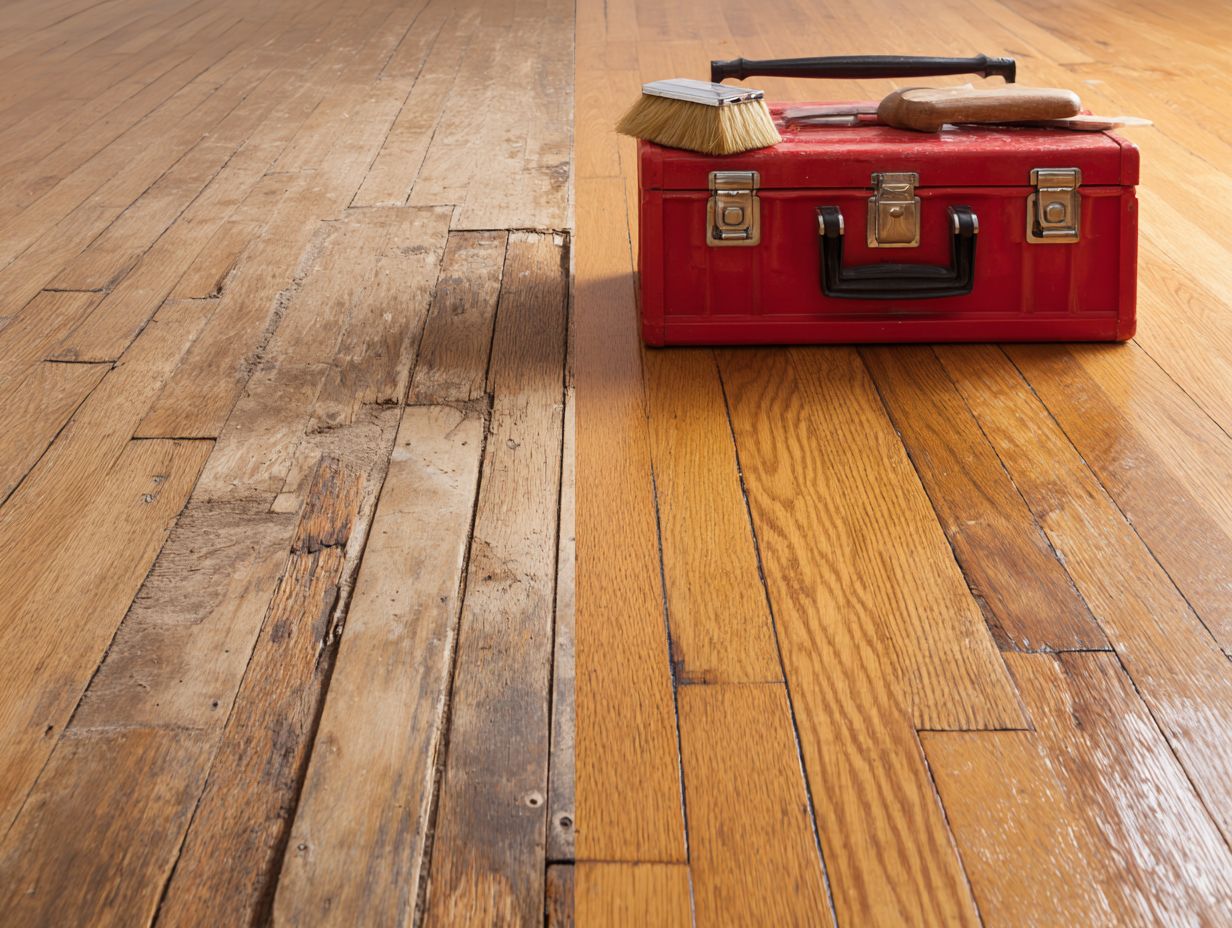
Knowing the costs involved in refinishing or replacing flooring is important for homeowners considering their choices.
Refinishing Costs
Refinishing hardwood floors can range from $2 to $5 per square foot, depending largely on location and the condition of the floor.
Along with the base cost, consider further expenses like labor, which typically adds $1 to $3 per square foot. For a standard 1,000-square-foot home, this can total $3,000 to $8,000.
If you opt for DIY refinishing, purchase tools such as a drum sander ($50-$100 per day rental) and finish products ($30-$100) for a more modest outlay.
Also, assess if additional services like repairs or staining are necessary, as these can significantly affect the overall price.
Planning and budgeting carefully will help keep your refinishing project within budget.
Replacement Costs
The cost of replacing flooring can vary widely but generally ranges from $5 to $15 per square foot, influenced by material choice and installation type.
For example, hardwood flooring typically costs between $8 and $15 per square foot, plus an additional $3 to $5 for professional installation.
In contrast, laminate flooring tends to be more budget-friendly, falling between $1 and $5 per square foot, with similar labor costs.
To minimize expenses, consider a DIY approach if you opt for laminate; online tutorials can guide you through the installation process.
Remember to factor in the cost of underlayment and trim, which can add another $1 to $2 per square foot.
Long-Term Value Considerations
Buying good flooring can raise your property’s value, make your home more comfortable, and save on repair costs later.
When deciding between refinishing or replacing your flooring, consider factors like resale value and longevity.
For instance, hardwood flooring retains around 75% of its value upon resale, especially when well-maintained. Refinishing a hardwood floor typically costs between $3 to $8 per square foot, extending its life for another decade.
Conversely, replacing it can exceed $15 per square foot but may increase property value significantly, especially in high-demand real estate areas. Analyze your local market trends to make a decision that aligns with your long-term investment goals.
Frequently Asked Questions
When should I consider refinishing my flooring instead of replacing it?
You should consider refinishing your flooring when it is still in good structural condition but has minor aesthetic issues such as scratches, dents, or fading. Refinishing can restore the appearance of your flooring without the cost and hassle of replacing it.
What are some signs that it’s time to replace my flooring?
Significant damage, extensive wear and tear, and major structural issues are all signs that it’s time to replace your flooring. Refinishing will not be effective in these cases and replacement will be necessary.
How do I determine if my flooring is in good enough condition to be refinished?
You can perform a simple test by pouring a small amount of water on your flooring. If the water beads up and does not soak into the wood, your flooring is probably still in good enough condition to be refinished.
Is refinishing or replacing flooring more cost-effective?
In most cases, refinishing is a more cost-effective option compared to replacing flooring. Refinishing typically costs a fraction of the price of replacement and can extend the lifespan of your flooring.
Can I refinish my flooring myself or should I hire a professional?
While refinishing can be a DIY project, it is recommended to hire a professional for best results. Hiring a professional to refinish your project will make sure it is done right and can save you both time and effort.
Will refinishing my flooring change its color or appearance?
Refinishing can change the color and appearance of your flooring depending on the type of stain or finish used. It is important to discuss your desired outcome with a professional before refinishing your flooring.

